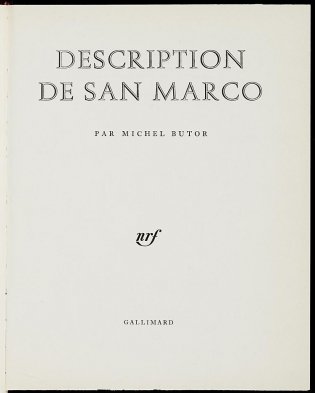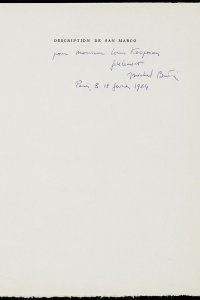Description de San Marco
Year: 1963
Author: Michel Butor (1926 - 2016)
Publisher: Gallimard
Bibliographical description
Description: Description de San Marco / par Michel Butor. - Paris: Gallimard, 1963. - [111] p. : ill. ; 25 cm
Printer: Firmin-Didot et Cie. (Mesnil-sur-l'Estrée, Eure)
Edition: 90 copies
This copy: Number 68 of 65 (numbered 26-90) on vélin pur fil Lafuma-Navarre
Bookbinder: Verschoor (Voorburg)
Note: With autograph dedication by the author
Shelfmark: KW Koopm A 716
References
- Els Jongeneel, Michel Butor et le pacte romanesque: Ecriture et lecture dans 'L'emploi du temps, Degres, Description de San Marco et Intervalle'. [No place: no name, 1986]
- Mary Lydon, Perpetuum mobile: A study of the novels and aesthetics of Michel Butor. Alberta, The University of Alberta Press, 1980
- Skimao et Bernard Teulon-Nouailles, Michel Butor. Lyon, La Manufacture, 1988



![Uitvouwbare plattegrond van de San Marco kathedraal (p. [113])](/sites/default/files/styles/galerie/public/images/description-de-san-marco-plattegrond.jpg?h=1035e1fc&itok=13V7r6h1)



